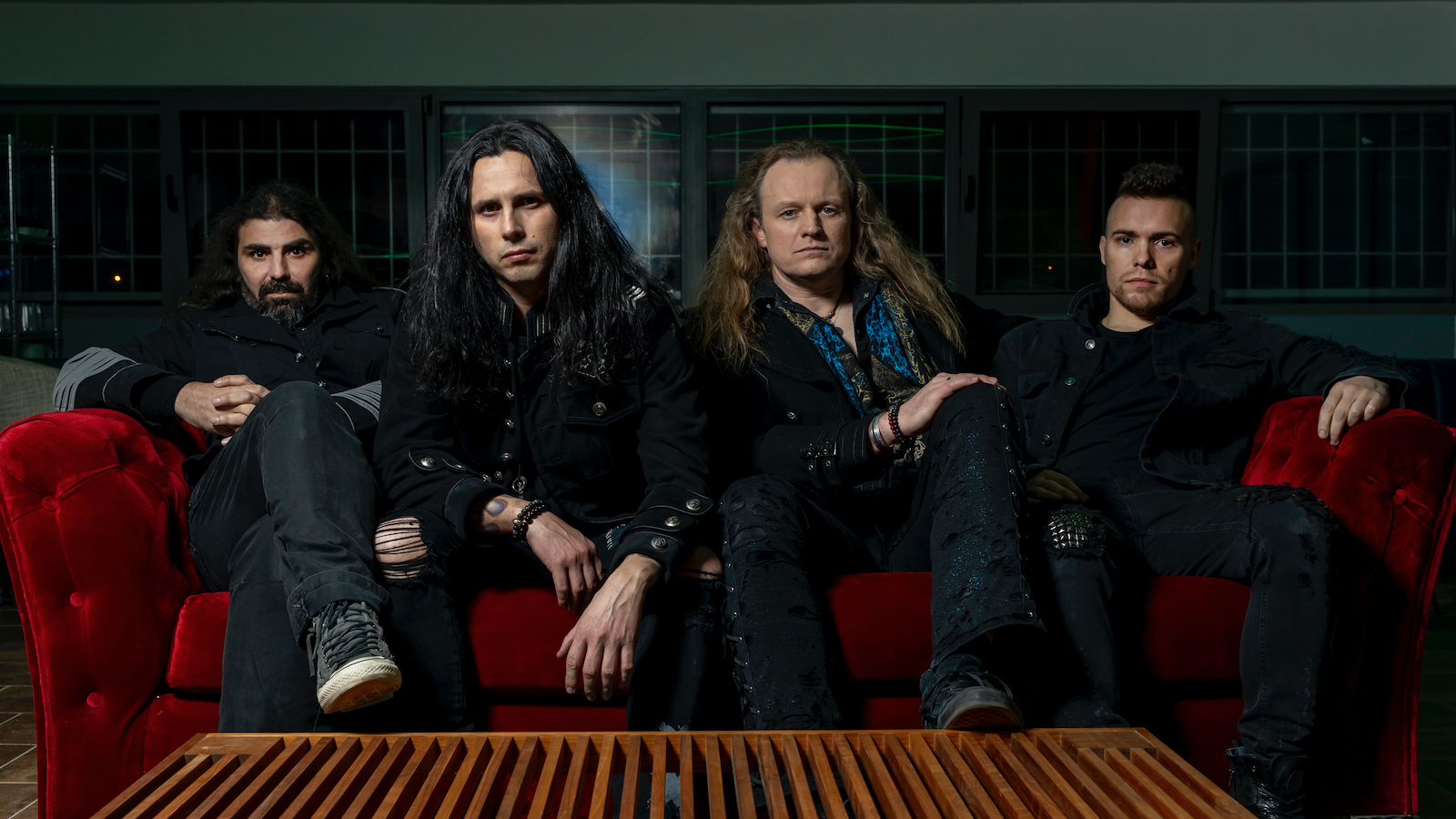Firewind: "This is the most complete Firewind record to date"
Firewind are officially back, and as Gus G fills us in, more fiery than ever before

Since their cataclysmic breakthrough at the turn of the 21st century, the Greek power‑metallers in Firewind have been at the forefront of heavy music’s most manic and monolithic high-points. Their first eight studio albums were met with universal acclaim, and despite having one of the loosest lineups in metal history (there are thrice as many ex‑members as there are active ones), each new iteration of Firewind seems to be even tighter and more tempestuous than the last.
As the sole founding member (and the core architect behind their sound since the earliest demos), axeman Gus G is effectively the key to Firewind’s success – his work on the fretboard is some of the metal genre’s most deft and dynamic, and such has never been more evident than on the band’s long‑awaited ninth album: a self-titled affair that Gus has declared to be a full-scale reinvention of Firewind.
The album itself plays out like a compilation of greatest hits that fans had previously never heard; the fuzz and fire of ‘80s power-metal is as prominent as the djenty spark that erupted in the 2010s. Naturally, we needed to figure out how Gus found a way to brew the definitive Firewind album over three decades into their tenure. To Skype, we ride!
What’s the significance in having this album be self-titled?
Well, it certainly is a significant record for Firewind. I look at it as a very monumental and very special moment in our career, and there are a couple of reasons why it’s a self-titled record. Firstly, it’s almost like a complete makeover for our band, because we switched singers; I mean, we’ve had different singers in the past, but it wasn’t just that – it was the way it happened. We lost [Henning Basse] and we also went from being a five-piece band to a four-piece when our keyboardist [Bob Katsionis] quit, so for me, it was like, “Okay, this is the right time to reimagine the band.”
It put me at a crossroads for a while, where I didn’t know if I even wanted to continue the band. I was like, “Well, maybe this is it. I don’t know how many more lineup changes we can handle.” And I was right in the middle of a production when the lineup change happened, so it was a bit like a wakeup call. I felt like, “Okay, I know I need to continue now, and if I’m going to do it, I need to do it on new terms, with a new approach.” So that was one thing.
The other thing was the material – the material that came out of our first sessions was almost like a collective of elements from all our previous records. I would say that this the most complete Firewind record to date – you’ll hear stuff you heard on the first album, all the way up to the most recent stuff we’ve done. So when it came time to decide on a title, I thought, “Well, this is the one.” You can see the cover – the new symbol rising out of the lava – and it’s like… This is it, y’know? This record is us.
What guitars did you have in the booth?
I played my signature model Jackson guitars. I recorded a lot with my new model that came out this year, which we launched at the NAMM show in January. I also used a Jackson Monarch for some of the rhythms – just a stock guitar, y’know? It was one of the guitars they sent me when I first started working with them, and I’ve always liked the way that guitar sounded. It has a shorter scale too – 24.75 inches, I think. I also used a ’61 reissue Gary Moore Strat. They only made 60 of those and I have one of them, and I used it for a lot of the clean parts and the stuff that required that single-coil sound.
Get The Pick Newsletter
All the latest guitar news, interviews, lessons, reviews, deals and more, direct to your inbox!
What made you want to team up with Jackson for your most recent signature models, as opposed to continuing with ESP?
The whole switch happened back in 2016. I think it was just a number of things – I still love ESP instruments, y’know, they make great guitars! But all the people I was working with and had a relationship with, they all ended up leaving the company. It got to a point where I had nobody to talk to, and nobody to approach if I wanted to design something new. There were no real plans for the future, and they they became less and less artist-focussed… Well, either that, or maybe they just lost interest in me – either way.
So there wasn’t any communication about what we were doing with the guitars, and to me, that’s when it’s not interesting anymore. I was like, “What are we doing here?” I’m into creating guitars and designing models and looking at new ideas, and I needed to be able to keep doing that. And then right around that time, my buddy Mike Tempesta, who’s the A&R of Jackson in the US, we had a conversation where he was like, “Dude, we’ll send you some guitars to check out.” And then when I was on tour in the States, I went to the Corona factory in California and met with everybody face to face.
They basically said, “We’ll build you a couple of guitars, and if you like them, cool, and if not, then you’ve got a couple of one-off customs.” Mike Shannon, one of their Master Builders – he made me a couple of guitars, and they were just f***ing great, man! It was a combination of the quality of the instrument, the excitement, and the work ethic of the team, y’know? When you’re doing something like an endorsement, you need to have the right team behind you.
Are you very hands-on in the design process?
They saw what I did with ESP for all those years, and we tried to make some things better and different. We went back and forth a lot – we all work on it together, y’know? We’ll go back and forth with each other’s designs and mockups and ideas, and we have all these calls and video meetings. And whenever I have the opportunity to, I go over to the factory and see how it all goes down. I want to say I’m pretty hands-on – I mean, I don’t really build them myself, but y’know, I’m there with the team and we’re always talking about what we’re going to do next.
What’s more interesting is that I recently decided to start my own pickup company. And I reached out to [Jackson] and said, “Look, I’m doing these pickups, it’s a new venture for me – would you be interested in launching these guitars with my pickups in there?” So the new signature models have my own pickups on there. And that was a first for them as well, they’d never done something like that with an artist before.
What can you tell us about those pickups?
It was one of those things – kind of a necessity. And the fact that I could do it. It was pretty insane that… Y’know, it’s like… I was talking to my buddy Rob Chapman, who’s a famous YouTuber – we’ve been friends for years, and he started Chapman Guitars in a kind of similar way. I was talking to him about a year and a half ago and I said, “Look man, I want to do these pickups – I’m thinking of leaving Seymour Duncan.” It was the same thing as ESP, where there was nobody there to talk to anymore. And Chapman goes, “Dude, f*** it! If I can do it, you can do it!” So he encouraged me to do it. He even put me in touch with some of his people and some of the factories in Asia to make prototypes with.

Ellie Robinson is an Australian writer, editor and dog enthusiast with a keen ear for pop-rock and a keen tongue for actual Pop Rocks. Her bylines include music rag staples like NME, BLUNT, Mixdown and, of course, Australian Guitar (where she also serves as Editor-at-Large), but also less expected fare like TV Soap and Snowboarding Australia. Her go-to guitar is a Fender Player Tele, which, controversially, she only picked up after she'd joined the team at Australian Guitar. Before then, Ellie was a keyboardist – thankfully, the AG crew helped her see the light…
“The main acoustic is a $100 Fender – the strings were super-old and dusty. We hate new strings!” Meet Great Grandpa, the unpredictable indie rockers making epic anthems with cheap acoustics – and recording guitars like a Queens of the Stone Age drummer
“You can almost hear the music in your head when looking at these photos”: How legendary photographer Jim Marshall captured the essence of the Grateful Dead and documented the rise of the ultimate jam band










